Microeconomics Analysis and Market Forces
VerifiedAdded on 2020/03/01
|9
|1696
|235
Essay
AI Summary
This essay explores key microeconomic concepts, including demand, supply, and market equilibrium, using the example of ticket pricing. It discusses the impact of market forces on consumer behavior and the importance of reasonable pricing in achieving economic stability. The analysis highlights the relationship between primary and secondary markets and the role of competition in driving demand and supply dynamics.

Running head: MICROECONOMICS
MICROECONOMICS
Name of the student
Name of the university
Author note
MICROECONOMICS
Name of the student
Name of the university
Author note
Paraphrase This Document
Need a fresh take? Get an instant paraphrase of this document with our AI Paraphraser
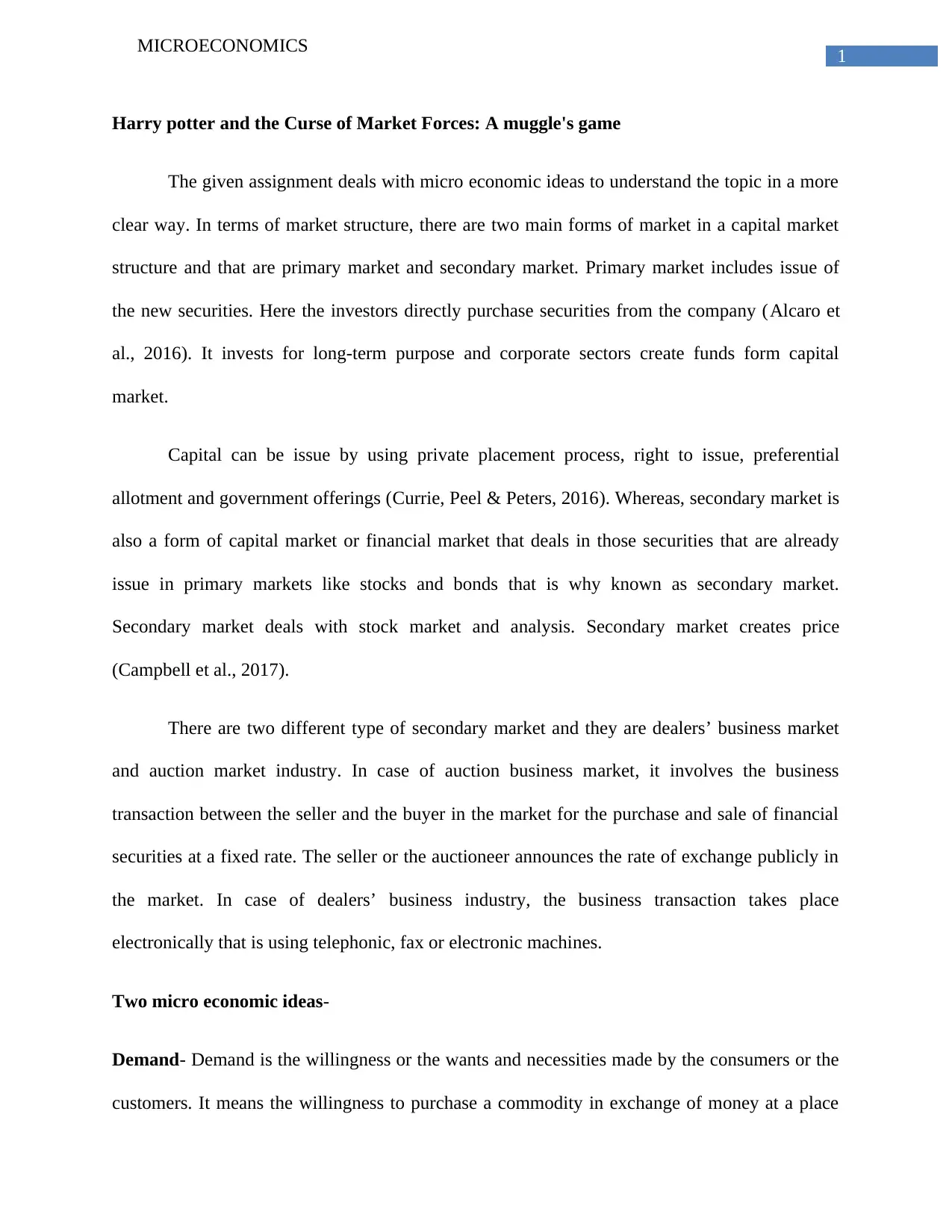
1
MICROECONOMICS
Harry potter and the Curse of Market Forces: A muggle's game
The given assignment deals with micro economic ideas to understand the topic in a more
clear way. In terms of market structure, there are two main forms of market in a capital market
structure and that are primary market and secondary market. Primary market includes issue of
the new securities. Here the investors directly purchase securities from the company (Alcaro et
al., 2016). It invests for long-term purpose and corporate sectors create funds form capital
market.
Capital can be issue by using private placement process, right to issue, preferential
allotment and government offerings (Currie, Peel & Peters, 2016). Whereas, secondary market is
also a form of capital market or financial market that deals in those securities that are already
issue in primary markets like stocks and bonds that is why known as secondary market.
Secondary market deals with stock market and analysis. Secondary market creates price
(Campbell et al., 2017).
There are two different type of secondary market and they are dealers’ business market
and auction market industry. In case of auction business market, it involves the business
transaction between the seller and the buyer in the market for the purchase and sale of financial
securities at a fixed rate. The seller or the auctioneer announces the rate of exchange publicly in
the market. In case of dealers’ business industry, the business transaction takes place
electronically that is using telephonic, fax or electronic machines.
Two micro economic ideas-
Demand- Demand is the willingness or the wants and necessities made by the consumers or the
customers. It means the willingness to purchase a commodity in exchange of money at a place
MICROECONOMICS
Harry potter and the Curse of Market Forces: A muggle's game
The given assignment deals with micro economic ideas to understand the topic in a more
clear way. In terms of market structure, there are two main forms of market in a capital market
structure and that are primary market and secondary market. Primary market includes issue of
the new securities. Here the investors directly purchase securities from the company (Alcaro et
al., 2016). It invests for long-term purpose and corporate sectors create funds form capital
market.
Capital can be issue by using private placement process, right to issue, preferential
allotment and government offerings (Currie, Peel & Peters, 2016). Whereas, secondary market is
also a form of capital market or financial market that deals in those securities that are already
issue in primary markets like stocks and bonds that is why known as secondary market.
Secondary market deals with stock market and analysis. Secondary market creates price
(Campbell et al., 2017).
There are two different type of secondary market and they are dealers’ business market
and auction market industry. In case of auction business market, it involves the business
transaction between the seller and the buyer in the market for the purchase and sale of financial
securities at a fixed rate. The seller or the auctioneer announces the rate of exchange publicly in
the market. In case of dealers’ business industry, the business transaction takes place
electronically that is using telephonic, fax or electronic machines.
Two micro economic ideas-
Demand- Demand is the willingness or the wants and necessities made by the consumers or the
customers. It means the willingness to purchase a commodity in exchange of money at a place
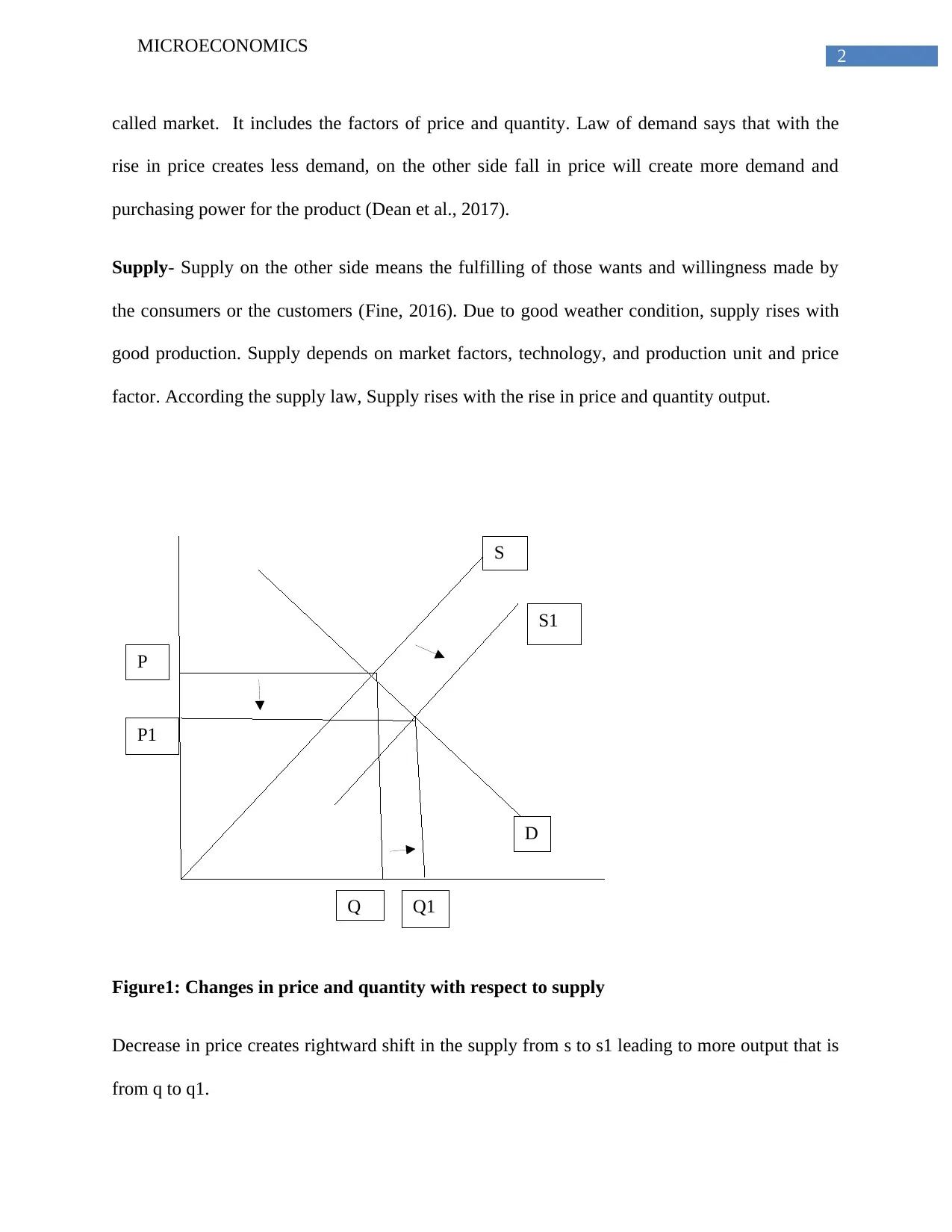
2
MICROECONOMICS
P
P1
S
S1
called market. It includes the factors of price and quantity. Law of demand says that with the
rise in price creates less demand, on the other side fall in price will create more demand and
purchasing power for the product (Dean et al., 2017).
Supply- Supply on the other side means the fulfilling of those wants and willingness made by
the consumers or the customers (Fine, 2016). Due to good weather condition, supply rises with
good production. Supply depends on market factors, technology, and production unit and price
factor. According the supply law, Supply rises with the rise in price and quantity output.
Figure1: Changes in price and quantity with respect to supply
Decrease in price creates rightward shift in the supply from s to s1 leading to more output that is
from q to q1.
Q Q1
D
MICROECONOMICS
P
P1
S
S1
called market. It includes the factors of price and quantity. Law of demand says that with the
rise in price creates less demand, on the other side fall in price will create more demand and
purchasing power for the product (Dean et al., 2017).
Supply- Supply on the other side means the fulfilling of those wants and willingness made by
the consumers or the customers (Fine, 2016). Due to good weather condition, supply rises with
good production. Supply depends on market factors, technology, and production unit and price
factor. According the supply law, Supply rises with the rise in price and quantity output.
Figure1: Changes in price and quantity with respect to supply
Decrease in price creates rightward shift in the supply from s to s1 leading to more output that is
from q to q1.
Q Q1
D
⊘ This is a preview!⊘
Do you want full access?
Subscribe today to unlock all pages.

Trusted by 1+ million students worldwide

3
MICROECONOMICS
D
S
E
p
Q
Equilibrium- Equilibrium is a point when the market forces of demand meets the supply the
economy said to be in equilibrium point and with reference to this topic, then lowering rates for
tickets will boost the demand and supply, creates equilibrium in the economy (Friedman, 2017 ).
Figure 2: Equilibrium point
Market achieves equilibrium point at e where demand meets the supply. E is DD= SS.
Equilibrium achieved in the market when the consumer demands meet the supply and this
happens when there is efficient allocation of economic resources that used efficiently and
effectively (Mazzone, 2017). As a result, firma achieves maximum productivity and output
thereby attains a good sum of profit. With good growth in the business and market, it creates
more line of production not only domestically but globally as well. When markets functions
MICROECONOMICS
D
S
E
p
Q
Equilibrium- Equilibrium is a point when the market forces of demand meets the supply the
economy said to be in equilibrium point and with reference to this topic, then lowering rates for
tickets will boost the demand and supply, creates equilibrium in the economy (Friedman, 2017 ).
Figure 2: Equilibrium point
Market achieves equilibrium point at e where demand meets the supply. E is DD= SS.
Equilibrium achieved in the market when the consumer demands meet the supply and this
happens when there is efficient allocation of economic resources that used efficiently and
effectively (Mazzone, 2017). As a result, firma achieves maximum productivity and output
thereby attains a good sum of profit. With good growth in the business and market, it creates
more line of production not only domestically but globally as well. When markets functions
Paraphrase This Document
Need a fresh take? Get an instant paraphrase of this document with our AI Paraphraser
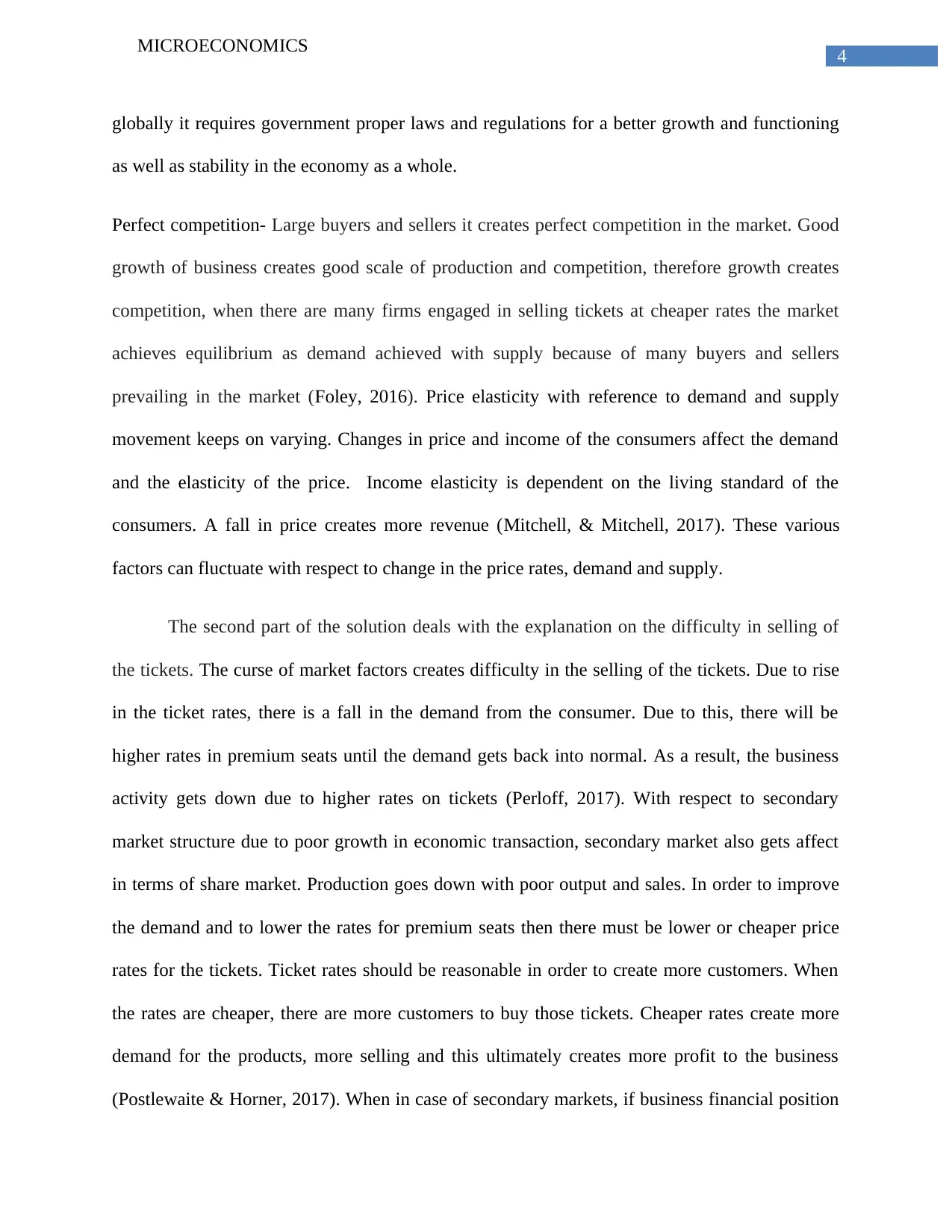
4
MICROECONOMICS
globally it requires government proper laws and regulations for a better growth and functioning
as well as stability in the economy as a whole.
Perfect competition- Large buyers and sellers it creates perfect competition in the market. Good
growth of business creates good scale of production and competition, therefore growth creates
competition, when there are many firms engaged in selling tickets at cheaper rates the market
achieves equilibrium as demand achieved with supply because of many buyers and sellers
prevailing in the market (Foley, 2016). Price elasticity with reference to demand and supply
movement keeps on varying. Changes in price and income of the consumers affect the demand
and the elasticity of the price. Income elasticity is dependent on the living standard of the
consumers. A fall in price creates more revenue (Mitchell, & Mitchell, 2017). These various
factors can fluctuate with respect to change in the price rates, demand and supply.
The second part of the solution deals with the explanation on the difficulty in selling of
the tickets. The curse of market factors creates difficulty in the selling of the tickets. Due to rise
in the ticket rates, there is a fall in the demand from the consumer. Due to this, there will be
higher rates in premium seats until the demand gets back into normal. As a result, the business
activity gets down due to higher rates on tickets (Perloff, 2017). With respect to secondary
market structure due to poor growth in economic transaction, secondary market also gets affect
in terms of share market. Production goes down with poor output and sales. In order to improve
the demand and to lower the rates for premium seats then there must be lower or cheaper price
rates for the tickets. Ticket rates should be reasonable in order to create more customers. When
the rates are cheaper, there are more customers to buy those tickets. Cheaper rates create more
demand for the products, more selling and this ultimately creates more profit to the business
(Postlewaite & Horner, 2017). When in case of secondary markets, if business financial position
MICROECONOMICS
globally it requires government proper laws and regulations for a better growth and functioning
as well as stability in the economy as a whole.
Perfect competition- Large buyers and sellers it creates perfect competition in the market. Good
growth of business creates good scale of production and competition, therefore growth creates
competition, when there are many firms engaged in selling tickets at cheaper rates the market
achieves equilibrium as demand achieved with supply because of many buyers and sellers
prevailing in the market (Foley, 2016). Price elasticity with reference to demand and supply
movement keeps on varying. Changes in price and income of the consumers affect the demand
and the elasticity of the price. Income elasticity is dependent on the living standard of the
consumers. A fall in price creates more revenue (Mitchell, & Mitchell, 2017). These various
factors can fluctuate with respect to change in the price rates, demand and supply.
The second part of the solution deals with the explanation on the difficulty in selling of
the tickets. The curse of market factors creates difficulty in the selling of the tickets. Due to rise
in the ticket rates, there is a fall in the demand from the consumer. Due to this, there will be
higher rates in premium seats until the demand gets back into normal. As a result, the business
activity gets down due to higher rates on tickets (Perloff, 2017). With respect to secondary
market structure due to poor growth in economic transaction, secondary market also gets affect
in terms of share market. Production goes down with poor output and sales. In order to improve
the demand and to lower the rates for premium seats then there must be lower or cheaper price
rates for the tickets. Ticket rates should be reasonable in order to create more customers. When
the rates are cheaper, there are more customers to buy those tickets. Cheaper rates create more
demand for the products, more selling and this ultimately creates more profit to the business
(Postlewaite & Horner, 2017). When in case of secondary markets, if business financial position
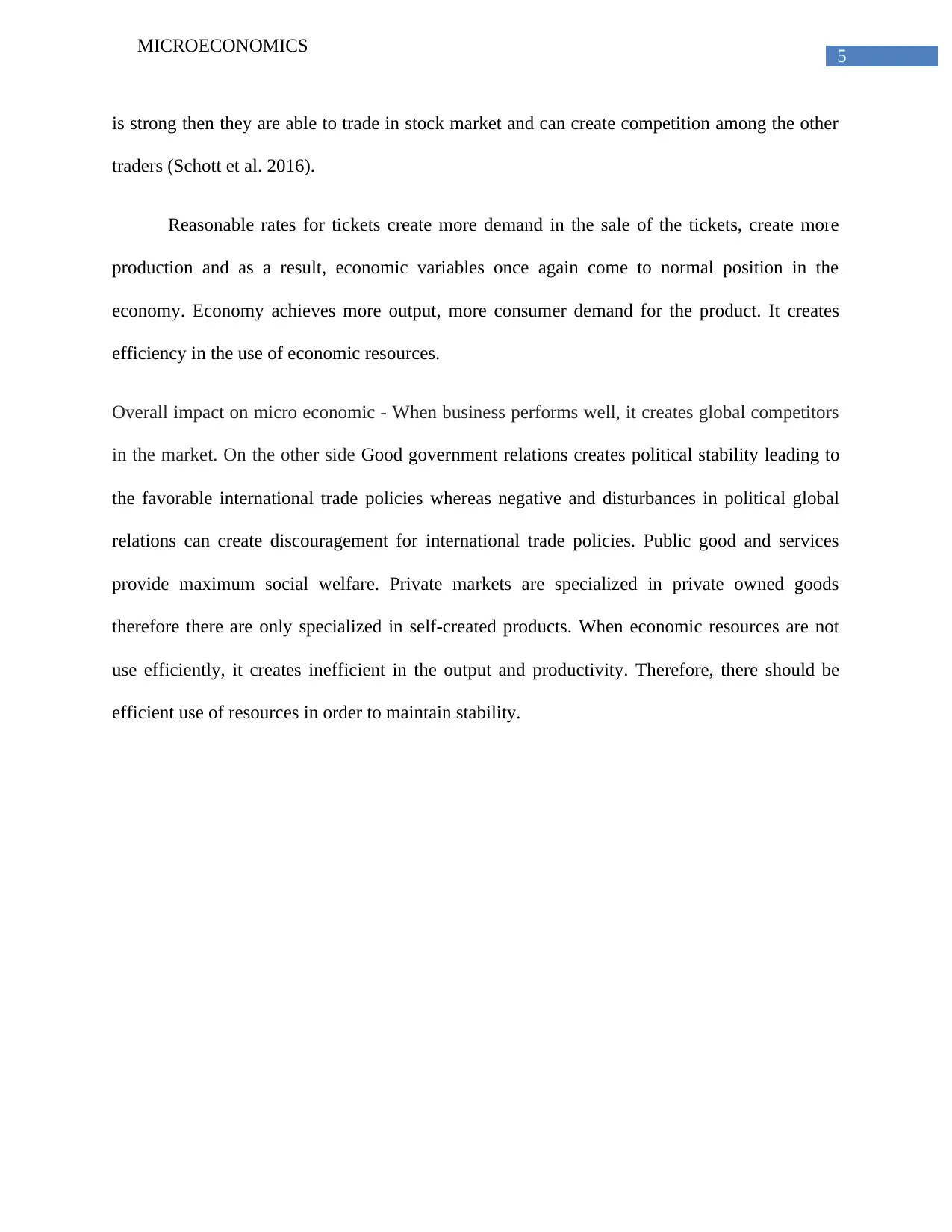
5
MICROECONOMICS
is strong then they are able to trade in stock market and can create competition among the other
traders (Schott et al. 2016).
Reasonable rates for tickets create more demand in the sale of the tickets, create more
production and as a result, economic variables once again come to normal position in the
economy. Economy achieves more output, more consumer demand for the product. It creates
efficiency in the use of economic resources.
Overall impact on micro economic - When business performs well, it creates global competitors
in the market. On the other side Good government relations creates political stability leading to
the favorable international trade policies whereas negative and disturbances in political global
relations can create discouragement for international trade policies. Public good and services
provide maximum social welfare. Private markets are specialized in private owned goods
therefore there are only specialized in self-created products. When economic resources are not
use efficiently, it creates inefficient in the output and productivity. Therefore, there should be
efficient use of resources in order to maintain stability.
MICROECONOMICS
is strong then they are able to trade in stock market and can create competition among the other
traders (Schott et al. 2016).
Reasonable rates for tickets create more demand in the sale of the tickets, create more
production and as a result, economic variables once again come to normal position in the
economy. Economy achieves more output, more consumer demand for the product. It creates
efficiency in the use of economic resources.
Overall impact on micro economic - When business performs well, it creates global competitors
in the market. On the other side Good government relations creates political stability leading to
the favorable international trade policies whereas negative and disturbances in political global
relations can create discouragement for international trade policies. Public good and services
provide maximum social welfare. Private markets are specialized in private owned goods
therefore there are only specialized in self-created products. When economic resources are not
use efficiently, it creates inefficient in the output and productivity. Therefore, there should be
efficient use of resources in order to maintain stability.
⊘ This is a preview!⊘
Do you want full access?
Subscribe today to unlock all pages.

Trusted by 1+ million students worldwide
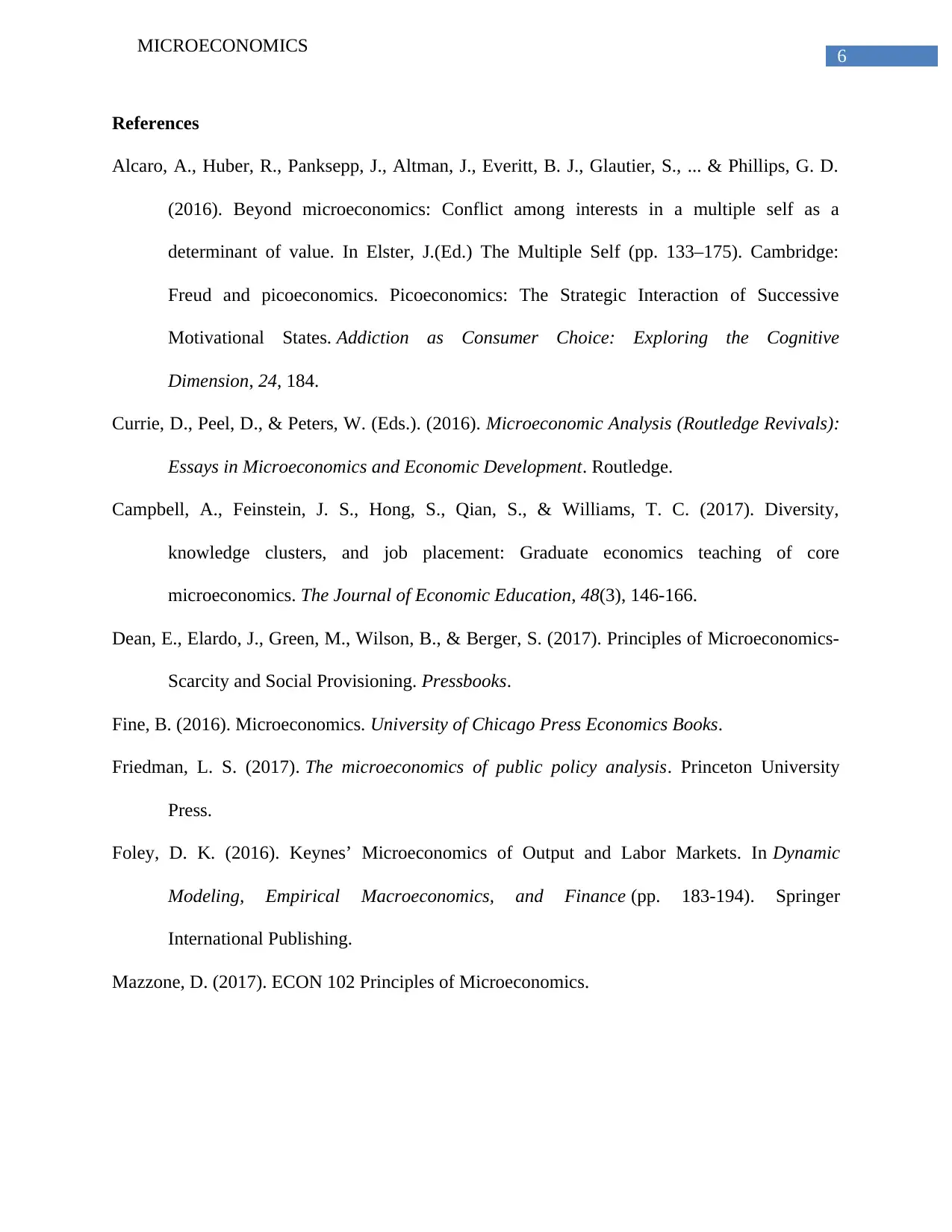
6
MICROECONOMICS
References
Alcaro, A., Huber, R., Panksepp, J., Altman, J., Everitt, B. J., Glautier, S., ... & Phillips, G. D.
(2016). Beyond microeconomics: Conflict among interests in a multiple self as a
determinant of value. In Elster, J.(Ed.) The Multiple Self (pp. 133–175). Cambridge:
Freud and picoeconomics. Picoeconomics: The Strategic Interaction of Successive
Motivational States. Addiction as Consumer Choice: Exploring the Cognitive
Dimension, 24, 184.
Currie, D., Peel, D., & Peters, W. (Eds.). (2016). Microeconomic Analysis (Routledge Revivals):
Essays in Microeconomics and Economic Development. Routledge.
Campbell, A., Feinstein, J. S., Hong, S., Qian, S., & Williams, T. C. (2017). Diversity,
knowledge clusters, and job placement: Graduate economics teaching of core
microeconomics. The Journal of Economic Education, 48(3), 146-166.
Dean, E., Elardo, J., Green, M., Wilson, B., & Berger, S. (2017). Principles of Microeconomics-
Scarcity and Social Provisioning. Pressbooks.
Fine, B. (2016). Microeconomics. University of Chicago Press Economics Books.
Friedman, L. S. (2017). The microeconomics of public policy analysis. Princeton University
Press.
Foley, D. K. (2016). Keynes’ Microeconomics of Output and Labor Markets. In Dynamic
Modeling, Empirical Macroeconomics, and Finance (pp. 183-194). Springer
International Publishing.
Mazzone, D. (2017). ECON 102 Principles of Microeconomics.
MICROECONOMICS
References
Alcaro, A., Huber, R., Panksepp, J., Altman, J., Everitt, B. J., Glautier, S., ... & Phillips, G. D.
(2016). Beyond microeconomics: Conflict among interests in a multiple self as a
determinant of value. In Elster, J.(Ed.) The Multiple Self (pp. 133–175). Cambridge:
Freud and picoeconomics. Picoeconomics: The Strategic Interaction of Successive
Motivational States. Addiction as Consumer Choice: Exploring the Cognitive
Dimension, 24, 184.
Currie, D., Peel, D., & Peters, W. (Eds.). (2016). Microeconomic Analysis (Routledge Revivals):
Essays in Microeconomics and Economic Development. Routledge.
Campbell, A., Feinstein, J. S., Hong, S., Qian, S., & Williams, T. C. (2017). Diversity,
knowledge clusters, and job placement: Graduate economics teaching of core
microeconomics. The Journal of Economic Education, 48(3), 146-166.
Dean, E., Elardo, J., Green, M., Wilson, B., & Berger, S. (2017). Principles of Microeconomics-
Scarcity and Social Provisioning. Pressbooks.
Fine, B. (2016). Microeconomics. University of Chicago Press Economics Books.
Friedman, L. S. (2017). The microeconomics of public policy analysis. Princeton University
Press.
Foley, D. K. (2016). Keynes’ Microeconomics of Output and Labor Markets. In Dynamic
Modeling, Empirical Macroeconomics, and Finance (pp. 183-194). Springer
International Publishing.
Mazzone, D. (2017). ECON 102 Principles of Microeconomics.
Paraphrase This Document
Need a fresh take? Get an instant paraphrase of this document with our AI Paraphraser
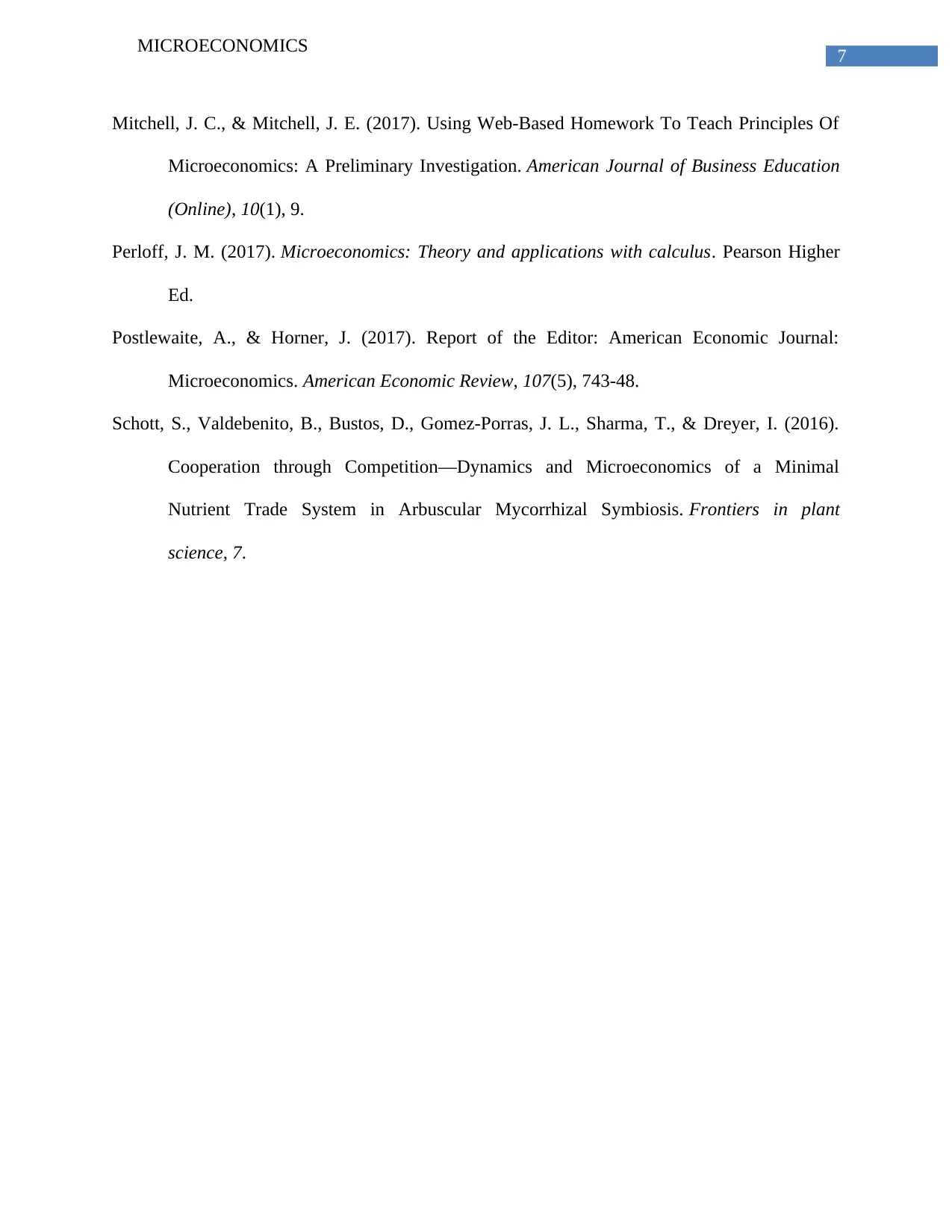
7
MICROECONOMICS
Mitchell, J. C., & Mitchell, J. E. (2017). Using Web-Based Homework To Teach Principles Of
Microeconomics: A Preliminary Investigation. American Journal of Business Education
(Online), 10(1), 9.
Perloff, J. M. (2017). Microeconomics: Theory and applications with calculus. Pearson Higher
Ed.
Postlewaite, A., & Horner, J. (2017). Report of the Editor: American Economic Journal:
Microeconomics. American Economic Review, 107(5), 743-48.
Schott, S., Valdebenito, B., Bustos, D., Gomez-Porras, J. L., Sharma, T., & Dreyer, I. (2016).
Cooperation through Competition—Dynamics and Microeconomics of a Minimal
Nutrient Trade System in Arbuscular Mycorrhizal Symbiosis. Frontiers in plant
science, 7.
MICROECONOMICS
Mitchell, J. C., & Mitchell, J. E. (2017). Using Web-Based Homework To Teach Principles Of
Microeconomics: A Preliminary Investigation. American Journal of Business Education
(Online), 10(1), 9.
Perloff, J. M. (2017). Microeconomics: Theory and applications with calculus. Pearson Higher
Ed.
Postlewaite, A., & Horner, J. (2017). Report of the Editor: American Economic Journal:
Microeconomics. American Economic Review, 107(5), 743-48.
Schott, S., Valdebenito, B., Bustos, D., Gomez-Porras, J. L., Sharma, T., & Dreyer, I. (2016).
Cooperation through Competition—Dynamics and Microeconomics of a Minimal
Nutrient Trade System in Arbuscular Mycorrhizal Symbiosis. Frontiers in plant
science, 7.

8
MICROECONOMICS
MICROECONOMICS
⊘ This is a preview!⊘
Do you want full access?
Subscribe today to unlock all pages.

Trusted by 1+ million students worldwide
1 out of 9
Related Documents
Your All-in-One AI-Powered Toolkit for Academic Success.
+13062052269
info@desklib.com
Available 24*7 on WhatsApp / Email
![[object Object]](/_next/static/media/star-bottom.7253800d.svg)
Unlock your academic potential
Copyright © 2020–2025 A2Z Services. All Rights Reserved. Developed and managed by ZUCOL.





